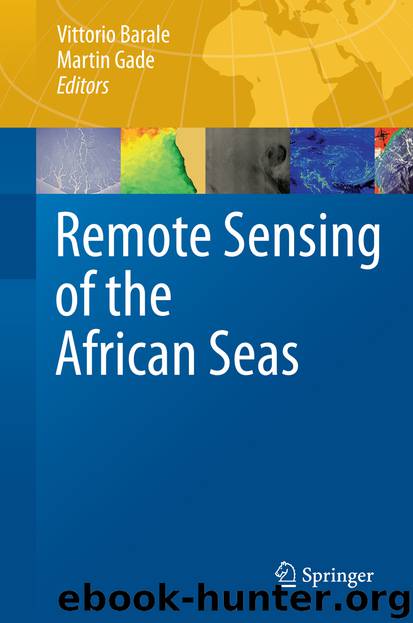Remote Sensing of the African Seas by Vittorio Barale & Martin Gade

Author:Vittorio Barale & Martin Gade
Language: eng
Format: epub
Publisher: Springer Netherlands, Dordrecht
11.1 Introduction
Oceanic eddies of horizontal scales ranging from several hundred meters to several hundred kilometers are ubiquitous phenomena in the World’s ocean (McWilliams 1985). This came as a great surprise to many oceanographers when the first images taken over the ocean from spacecraft became available. (see e.g., Cresswell and Legeckis 1986; Stevenson 1998; Munk et al. 2000; Siegel et al. 2001). Boundaries of strong currents, like the Gulf Stream and the Agulhas Current, and upwelling regions, like the Canary upwelling area, are preferred regions of eddy generation. Eddies strongly affect the dynamics of the ocean and can transfer heat, salt, trace gases, nutrients, and CHL across frontal zones (see e.g., Olson 1991; Morrow et al. 2003). In particular, they also can transport nutrients from upwelling regions into oligotrophic ocean regions causing enhanced CHL concentration there (Falkowski et al. 1991; Levy et al. 2001; Lin et al. 2010). Although already more than 30 years ago, Gower et al. (1980) have pointed out that phytoplankton patchiness is linked to mesoscale eddies, it has been realized only recently that eddies play a key role in the variability of the CHL distribution in the World’s ocean (Williams 2011). Chelton et al. (2011) state that most of the variability of CHL distribution results from redistribution of CHL caused by advection with the mesoscale flow field and not from changes in the local phytoplankton growth.
Often oceanic eddies are divided into mesoscale and submesoscale eddies with horizontal scales above and below the first baroclinic Rossby radius of deformation, respectively. The Rossby radius is larger than 100 km in the inner tropics, around 50 km in the upwelling region off West Africa and becomes smaller towards north reaching about 10 km in the subpolar gyre (Chelton et al. 1998). Mesoscale eddies having spatial scales above 100 km have been studied intensively in the last two decades by using radar altimeter (RA) data and by assimilating them in global ocean circulation models. They are measured by altimeters via sea surface height anomalies from which current velocities are retrieved by using the geostrophic approximation (see e.g., Fu and Holt 2008; Chelton et al. 2011). Present-day global ocean circulation models have horizontal resolutions of the order of 10 km and thus are suited for modeling mesoscale oceanic eddies, but not submesoscale ones (Maltrud and McClean 2005; Le Galloudec et al. 2008; Capet et al. 2008).
Mesoscale eddies can be detected from satellites also by infrared and optical sensors, like the Moderate Resolution Imaging Spectroradiometer (MODIS) onboard the Terra and Aqua satellites, and by Synthetic Aperture Radars (SARs). However, these sensors are not well suited to study the dynamics of mesoscale eddies systematically. Optical/infrared sensors provide useful data only when there are no or only few clouds in the imaged scene. On the other hand, SAR data are not dependent on cloud coverage and the time of the day, but their application is limited by the fact that a given ocean area is imaged very infrequently by a SAR on a single satellite
Download
This site does not store any files on its server. We only index and link to content provided by other sites. Please contact the content providers to delete copyright contents if any and email us, we'll remove relevant links or contents immediately.
Sass and Compass in Action by Wynn Netherland Nathan Weizenbaum Chris Eppstein Brandon Mathis(13260)
Autodesk Civil 3D 2024 from Start to Finish by Stephen Walz Tony Sabat(7408)
Mathematics for Game Programming and Computer Graphics by Penny de Byl(7310)
Taking Blender to the Next Level by Ruan Lotter(7123)
Express Your Creativity with Adobe Express by Rosie Sue(6911)
Hands-On Unity 2022 Game Development - Third Edition by Nicolas Alejandro Borromeo(6571)
Hands-On Unity 2022 Game Development by Nicolas Alejandro Borromeo(5232)
Unreal Engine 5 Character Creation, Animation, and Cinematics by Henk Venter & Wilhelm Ogterop(4124)
Going the Distance with Babylon.js by Josh Elster(4079)
Squeaky Clean Topology in Blender by Michael Steppig(3984)
Mastering Graphics Programming with Vulkan by Marco Castorina & Gabriel Sassone(3973)
Adobe Illustrator for Creative Professionals by Clint Balsar(3776)
Drawing Shortcuts: Developing Quick Drawing Skills Using Today's Technology by Leggitt Jim(3036)
Unreal Engine 5 Character Creation, Animation, and Cinematics by Henk Venter Wilhelm Ogterop(2942)
Rapid Viz: A New Method for the Rapid Visualization of Ideas by Kurt Hanks & Larry Belliston(2868)
The 46 Rules of Genius: An Innovator's Guide to Creativity (Voices That Matter) by Marty Neumeier(2816)
Learn Qt 5: Build modern, responsive cross-platform desktop applications with Qt, C++, and QML by Nicholas Sherriff(2493)
Fusion 360 for Makers by Lydia Sloan Cline(2333)
Realistic Asset Creation with Adobe Substance 3D by Zeeshan Jawed Shah(2253)
